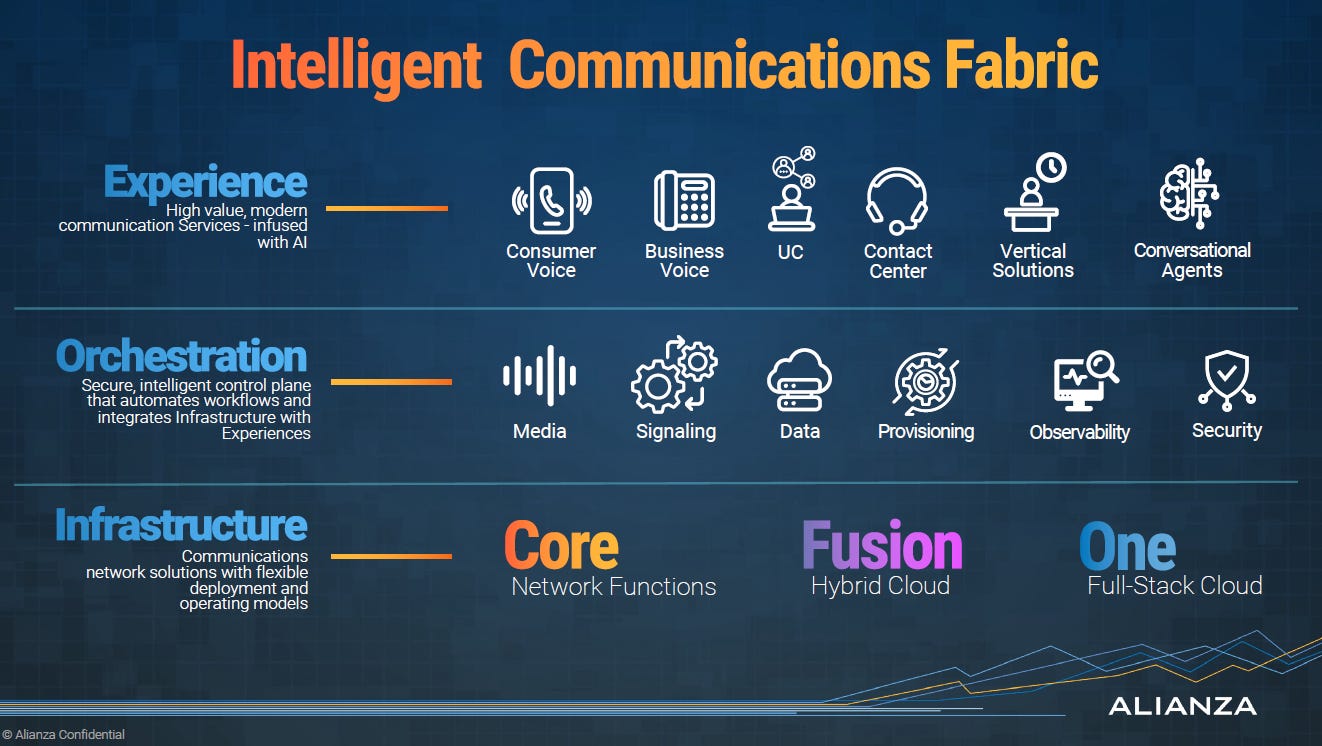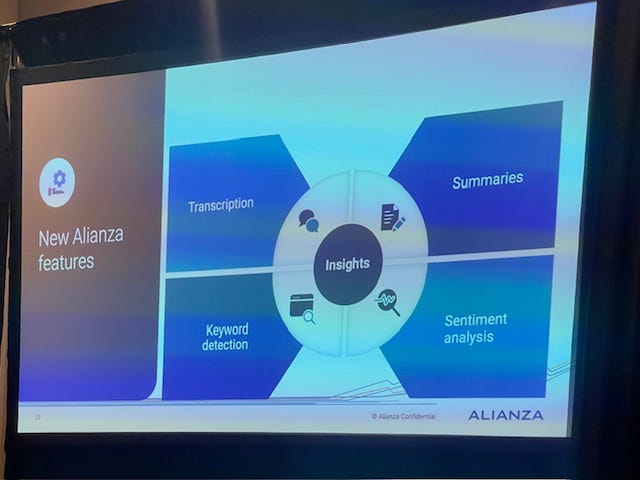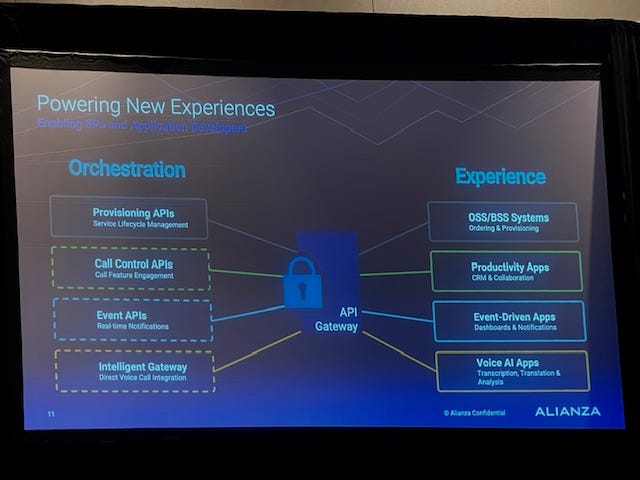Event Report: Alianza Navigate 25
Telco Voice Platforms - putting the band back together
This week I was at Alianza’s Navigate’25 event in Salt Lake City. Alianza focuses on telco voice/comms infrastructure and cloud-managed platforms, both for smaller operators and some large global tier-1’s, right up to their critical emergency-call systems. The portfolio includes both hosted PSTN solutions for residential users, and business telephony / unified comms for enterprises, as well as products such as SBCs*.
Navigate had about 650 attendees, representing telco/ISP clients and partners from both Alianza’s own historic base, and especially those it gained from its recent acquisition of Metaswitch’s assets from Microsoft.
The event gave a great insight into the existing and possible future “in-house” telco opportunities around communications services, based on owned systems or hosted/managed cloud platforms. The emphasis was on telco-branded business and residential voice-based services, rather than mobile, video or messaging. This contrasts with the 3rd-party, standalone UCaaS or CPaaS-centric views of the world - and is also very different to mobile-centric approaches to voice/video (eg IMS).
The central objective of Navigate was bringing together Alianza’s customer groups and historic product sets, and demonstrating a shared roadmap and a cohesive future trajectory, linked to AI and its role in voice applications and services.
I’ve known both Alianza and Metaswitch for a long time. In particular, I used to be a regular speaker at Metaswitch events before its acquisition by Microsoft, both in the US and also its Enfield offices near London. I’ve followed Alianza since about 2016.
Like the earlier events, Navigate was very ably steered by its own map-reader and MC, the inimitable Steve Gleave. He curated a masterful narrative arc, with lengthy intro segments and videos about famous explorers (representing audacity and adaptability), honeybees (teamwork), turtles (longevity and sense of direction) and The Renaissance era (self-explanatory).
There were also amazing guest keynote speakers Tim Urban, who talked about avoiding procrastination, and dog-mushing race-winner Dallas Seavey, who gave a great perspective on teamwork and perseverance. Former Metaswitch CEO John Lazar appeared by video for a chat with Alianza head Brian Beutler, also referencing his involvement in WhatThreeWords, which nicely fit the navigation narrative too.
Dom Black from Cavell and I also gave keynote analyst presentations about the AI-led Voice Renaissance and telcos’ role in it - Dom mostly about enterprise and UCaaS / CCaaS, with my session more oriented to consumers and residential AI-infused voice services. I’ll write a separate post with my slides and narrative, in coming days.
(For my wireless / spectrum readers: session border controllers or SBCs are sort of “comms gateways” that act like a mix of firewall, protocol/codec translators and various other functions, at interconnect points. I think there could be some parallels in future 6G networks and telco AI/APIs. More in future.)
Intelligent Communications Fabric
The main product story from Navigate was the rationalisation, rebrand and extension of the two companies’ product lines into a new three-tier approach, which Alianza calls the Intelligent Communications Fabric.
This is intended to help operators modernise their voice / comms infrastructure, control it better, and offer new services and experiences, while recognising that progress to full “cloud-native” platforms will take different paths and speeds for each telco.
It also bridges between owned / self-managed elements, and those which are hosted or managed by Alianza as an XaaS provider. It can also link to 3rd-party applications such as MS Teams. This reflects market reality and varying levels of conservatism and in-house skills at different telcos. Some infrastructure - especially for emergency calls - may continue to rely on dedicated in-house functions, while other elements can be hosted in public, private or hybrid cloud. Nobody is a “purist”.
The infrastructure layer comprises three options:
Core: This incorporates Metaswitch’s historic physical and virtualised network functions such as its Call Feature Server (CFS), Perimeta SBCs and Rhino application platform. These are deployed and run by the CSP itself.
Fusion: This is the new hybrid cloud, based on the “core” products, but managed by Alianza. It uses a combination of public datacentres (based on AWS, which sent a speaker to the event), and Alianza’s own sites.
One: This is the “full stack cloud”, representing Alianza’s own traditional fully-hosted, cloud-native platform for home phone service, business lines, UCaaS elements and ancillary capabilities such as device management and OSS/BSS integration.
The orchestration layer is the important-but-unglamorous bit which supports future service expansion and exposure - the data management, media control, signalling, provisioning, observability and security functions. It’s easy to overlook this, but it’s central to future opportunities that bridge standard comms protocols such as SIP, with external simpler APIs - and AI capabilities, perhaps via something like MCP in future.
Above this, Alianza is working on its ideas for “experiences”, and especially AI-powered communications services, such as next-gen contact centres, in-call AI monitoring (such as the anti-spam, anti-scam and call-assistant ideas that are already emerging), and API exposure to third parties.
From an analyst perspective - albeit without the same depth of coverage of UCaaS and voice as I had a few years ago - this seems sensible and cohesive. I like the logic of enabling telcos to craft their own comms services, while abstracting away much of the heavy lifting involved in running and maintaining lots of boxes. And I also like the realism that not everything can be opex-based managed services - attitudes to hosted capabilities and cloud will vary, even across different parts of the same operator.
In the (sometimes distant) past I’ve advised companies such as Voxygen, Working Group Two, Broadsoft, Acme Packet and Radisys (all since acquired by others) with broadly similar visions for cloud-based or hybrid programmable comms.
Work in progress
There were some interesting early examples of AI use-cases discussed during the event, both embedded into the various “experience” offers, and intended for exposure to partners and long-tail developers.
A key element here is live, in-call analytics, going beyond familiar themes like transcription and translation. While there are obviously plenty of privacy and consent constraints, there are various ways to manage that. For instance a non-whitelisted unknown caller might have to consent to call recording and keyword monitoring, or hang up. I also really liked an example written up by Diana Goovaerts at Fierce, about BT’s attempt to layer voice analytics onto emergency calls, detecting distress or medical symptoms.

It’s up for debate whether the key value of AI will come from being directly in the call path, or in the metadata and adjacent input sources such as IoT, BSS/OSS or end-user context (eg is someone driving, or in an area with patchy network coverage).
It seems clear that Alianza’s ICF architecture is an ongoing work-in-progress, especially for the experience layer. While there was some discussion around APIs, it is unclear exactly which developers are being targeted, with which tools and support, or through which channels.

At present, Alianza doesn’t have an explicit developer programme, either for telcos’ own product teams, the telcos’ enterprise customers creating inhouse resources, or for purely external 3rd-party developers. It’s also a bit unclear how its API initiatives might align with larger (and louder) calls for telcos’ and developers’ attention from TMForum, CAMARA, mplify and others.
I expect the next year to clarify a bit more of that, and for more AI-fuelled use-cases and case studies to emerge.
Also missing was a clear mobile proposition (for instance, about IMS and the mobile voice / comms domain), and also a view on how Alianza-powered telcos could potentially align with industry-wide developments, such as API initiatives like CAMARA, or the TMForum’s ODA.
Back to the “telco vs OTT” rhetoric
If there was one thing I didn’t like about Navigate, it was the rather cringeworthy rhetoric about “OTTs”, which seemed like a throwback to 2013.
There was the hackneyed capex-vs-revenue “scissor” chart for the telecoms industry, which ignores the one-time, 30-year investment in fibre + generational upgrades to mobile. There was the usual “blame it on WhatsApp & Google” story, although it mostly swapped out Netflix and YouTube, for Zoom and Twilio as the stereotyped “bad guys”.
There were ancient “they’re using your pipes” tropes, which ignores the reality of full-spectrum tech companies investing trillions in datacentres, their own chips, and cutting-edge devices and AI platforms. “CSPs built the roads …but OTTs are collecting the tolls”. Even that analogy doesn’t work - I don’t hear road construction companies complaining that Ford, Tesla or BP are making more money than them.
Given the audience of mostly smaller telcos and small-business hosted voice players, I can understand that there’s a temptation to use simple “them and us” narratives. But this is the wrong approach.
There isn’t a “monetisation gap” - there’s a “product gap” - and I’m also pretty sure that most rural telcos are more worried about revenue attrition from Starlink or 5G FWA, tariffs on equipment, or shifting rules for government subsidies, than competition from Microsoft Teams or WebEx.
Conclusion
Overall, an excellent, informative and entertaining event, which gave a rather different perspective on voice+AI, next-gen telco voice infrastructure, and potential new revenue opportunities, to many that I hear.
Rather than leaning entirely on CPaaS and 3rd-party UCaaS or B2C app vendors, it tries to push the nexus of control and monetisation back into telcos’ own infrastructure. A lot of recent voice innovation has bypassed operators - partly as it’s been baked directly into apps and devices, but also because operators have avoided anything doesn’t look like a vanilla phone call.
Watch out for another upcoming Substack article about my own keynote. This was forward-looking and covered the wider potential for AI to lead a renaissance in voice communications, including new roles addressable by telcos. I’ll be uploading the slides and describing my full narrative soon.
Potentially, Alianza’s ICF enables a change - although there’s a lot of attitude shift and hard work needed in telcos to embrace the idea of new services in the long-overlooked voice domain. All the comments about perseverance, taking action, undertaking trials, and seeking out partners and team-mates apply here.
For enterprise and small-business, there’s a lot of theoretical opportunity in offering specialised vertical and horizontal services, or exposing core enablers, APIs or other building blocks. For residential consumers who mostly nowadays avoid PSTN or fixed telephony, it’s a harder hill to climb. We’re not obviously going to make the wired (or cordless) phone cool again. But there’s a lot of scope around voice-enabled health and social care functions, perhaps integrated with smart speakers, TVs or a range of IoT devices.
My sense is that the Alianza model of blending cloud-voice platforms, with legacy migration and AI/API integration has potential. Some telcos are already innovating with it.
But the real complexity will be the future “multi-stakeholder” nature of both telecoms and AI. Most of the coolest use-cases will inevitably involve a mix of operators, cloud hyperscalers, AI specialists, device vendors and niche application developers. There’s going to a lot of regulators and legal specialists involved as well.
It should be possible to Navigate that maze (sorry for the pun), but it’s going to need a lot of partnerships and also forward-thinking from the telcos.
___________________________________________________________________________
If you’d like to discuss this theme more, please reach out to me. And you may also be interested in the next Unthinkable Lab workshop I’m running in London on November 6th, about Voice & AI. Details and registration are here




